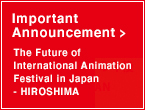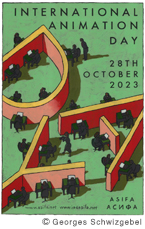
FAQ: The Future of the International Animation Festival in Japan – HIROSHIMA
We have collected questions sent to ASIFA (International Animated Film Association) and ASIFA-JAPAN (ASIFA’s Japan branch) regarding the future of the International Animation Festival in Japan – HIROSHIMA (a.k.a. Hiroshima Festival), and published them below alongside our answers in a Q&A format. We will update this page as and when we receive further inquiries.
Q1. Hiroshima Festival
Q1-1: Has Hiroshima Festival ended?
A1-1: We regret that Hiroshima Festival, as endorsed by ASIFA and co-organized by ASIFA-JAPAN, ended after its 18th edition, which was held in August 2020.
Q1-2: Why did it end after its 18th edition?
A1-2: In November 2019, the city of Hiroshima declared out of the blue: “Hiroshima Festival will cease to exist in its current form after its 18th edition. In 2022, the city will launch a new ‘general arts and culture event’ [provisional title], which will feature animation. But ASIFA (and ASIFA-JAPAN) will not be involved.”
Over many years, ASIFA and ASIFA-JAPAN worked with the city to develop Hiroshima Festival into an animation festival of the highest caliber, to the point where it was even recognized as a qualifying festival by the Academy Awards and the Annie Awards. We were just about to launch a new plan aimed at building further on these achievements. We were greatly surprised by the city’s sudden declaration, which was made without prior consultation or discussion with ASIFA, which co-founded and endorsed the festival, or ASIFA-JAPAN, which co-founded and co-organized it.
Q1-3: Wasn’t Hiroshima Festival founded through a collaboration between ASIFA/ASIFA-JAPAN and the city of Hiroshima?
A1-3: Hiroshima Festival was established in the spirit of “Love and Peace.” It was born of a vision shared by the city of Hiroshima, which wishes for lasting peace, and ASIFA/ASIFA-JAPAN, which aims to spread international friendship and understanding through the advancement of animation. Renzo Kinoshita (then a Board Member of ASIFA and the President of ASIFA-Japan) and Sayoko Kinoshita (then the General Secretary of ASIFA-Japan, now President of both ASIFA and ASIFA-JAPAN) devoted themselves to making the festival a reality, and it was founded in 1984 after they received the support of Mr. Takeshi Araki, who was then serving as the mayor of Hiroshima.
At the outset, we agreed that we would hold the festival uninterruptedly, placing the art of animation at the heart of our vision to create an “artistic and cultural forest” in Hiroshima, which seeks to be a city of international peace and culture in the truest sense. The first edition was held in 1985 to commemorate the 40th anniversary of the bomb. The festival was then held continually, with ASIFA’s endorsement and ASIFA-JAPAN as co-organizer, up to the 18th edition in 2020. The fact that Hiroshima Festival was able obtain ASIFA’s endorsement from its very first edition is special.
Q1-4: Why is the fact that Hiroshima Festival obtained ASIFA’s endorsement from its first edition special?
A1-4: Only festivals that have managed to hold successive editions while observing ASIFA’s international competitive festival rules can receive ASIFA’s endorsement. It was therefore highly unusual that the festival was endorsed from its first edition. Before the festival’s first edition, Mayor Takeshi Araki asked ASIFA for its endorsement; ASIFA gave it on the condition that ASIFA-JAPAN would be responsible for running the event as co-organizer.
Q1-5: What were the respective roles of ASIFA-JAPAN and the city of Hiroshima in the hosting of Hiroshima Festival?
A1-5: Under the direction of Festival Director Sayoko Kinoshita, ASIFA-JAPAN, as co-organizer, was responsible for the festival’s global operation and for programming the animation competition, special programs, and so on. The city of Hiroshima was in charge of the financing.
Q1-6: Isn’t ASIFA-JAPAN asking the city of Hiroshima to keep the festival going?
A1-6: ASIFA-JAPAN has requested many times, both verbally and in writing, that the city continue the festival in its current form, but the city has not changed its mind. ASIFA-JAPAN has also asked for the opportunity to exchange ideas with the city, to no avail; the city has merely reasserted its existing position. Meanwhile, it has forged ahead with preparations for the new event and even appears to have set up an exploratory committee. We regret the fact that the city decided to end Hiroshima Festival and start preparing for a different event without even first consulting ASIFA, which co-founded and endorsed the festival, or ASIFA-JAPAN, which co-founded and co-organized it.
Q2. The City of Hiroshima’s New Policy
Q2-1: Why did the city of Hiroshima unilaterally decide to end the festival and turn it into a new event, without consulting ASIFA or ASIFA-JAPAN?
A2-1: Time and again, both verbally and in writing, we have asked them to give their reasons, but we have yet to receive a clear explanation. Instead, the city merely repeats what it has already said about its new policy. It says: “Hiroshima Festival is highly artistic, and as such it has not been embraced by the local population. We want to make the new ‘general arts and culture event’ [provisional title] more accessible to the public. We want it to help boost the number of foreign visitors to Hiroshima and stimulate the local audiovisual content industry — to revitalize the economy, promote tourism, and generally contribute to the city’s prosperity.”
Yet Hiroshima Festival, while serving as an international film festival, has also been contributing to tourism and providing cultural and educational opportunities to young people from the area. It seems that, rather than spread the message of “Love and Peace” to the world as a city of international peace and culture, the city of Hiroshima has chosen to go further than before in prioritizing financial gain.
Q2-2: What does ASIFA-JAPAN think of the city’s assessment of Hiroshima Festival, and of its plan for a new event?
A2-2: We are unsure what the city means by “artistic,” but if it believes that the public is put off because the event is highly artistic, then it must not credit people with much sensibility or appreciation of art. Not only that, by describing short films that display a strong auteurist streak as “highly artistic,” it is effectively saying that commercial productions such as theatrical features, TV series, and commercials lack artistry, which we believe is offensive to these works too.
ASIFA-JAPAN does not distinguish between shorts, features, and series: in our view, all animation is art. While the festival’s competition has been limited to shorts, we have screened a variety of animation, including features, series, and commercials, in the special programs. The length of a work and the context in which it is seen have nothing to do with “artistry” in its original sense.
Q3. The “Animation Section” at the City of Hiroshima’s New Event
Q3-1: The city of Hiroshima says it will establish an “animation section,” which will include an international competition, as part of its new event. Is that true?
A3-1: That is what we are hearing from the city. Moreover, in a planning document which can be found on the city’s official website, it is written that an animation competition and animation programs will be held as part of the “media arts genre” section of the event.
Q3-2: Will the new event’s “animation section” be a successor to past editions of Hiroshima Festival?
A3-2: It will be a separate event and completely different from the festival. The city’s plan shows that it is trying to position the new event’s “animation section” as a successor to Hiroshima Festival. However, when the co-organizer ASIFA-JAPAN — which was closely involved with the founding and running of Hiroshima Festival, and developed it into an animation festival of the highest caliber — is replaced by new management with new aims, it is only natural to conclude that the resulting event cannot be seen as a successor to the festival. The way in which the city is trying to inherit only the festival’s successes makes no sense to us.
Q3-3: Will ASIFA and ASIFA-JAPAN be involved with the new event’s “animation section”?
A3-3: ASIFA and ASIFA-JAPAN have no plans to participate in the new event organized by the city.
Q3-4: Will ASIFA endorse the new event’s “animation section”?
A3-4: As the festival is becoming a different event, ASIFA is withdrawing its endorsement for the time being. For a festival to receive ASIFA’s endorsement, it must be run according to the strict standards established by ASIFA’s international competitive festival rules. The festival has to maintain an internationally recognized standard of quality in all aspects of its operation, from the competition and special programs to the invitation of filmmakers and other guests, public relations, copyright protection, and the guarantee of freedom of expression. In recent years, Hiroshima Festival was the only festival in the world to be endorsed by ASIFA.
Q3-5: Is it difficult to obtain ASIFA’s endorsement?
A3-5: Aside from Hiroshima Festival, the other three of the “four major” animation festivals — Annecy, Zagreb, and Ottawa — are now partnered with ASIFA but not endorsed by it. The reason is that it is extremely difficult to adhere to ASIFA’s rules. The “animation section” of the city of Hiroshima’s new event will not be eligible for ASIFA’s endorsement until it has built up a track record over several successive editions while meeting all of ASIFA’s strict standards, including in its international competition.
Q3-6: Will the new event’s “animation section” still be able to describe itself as one of the “four major” animation festivals?
A3-6: It will not. The reason is that the new event’s “animation section” will differ in its aims, contents, and organizational structure from past editions of Hiroshima Festival.
Q3-7: Will the new event’s “animation section” be recognized as a qualifying festival by the Academy Awards and the Annie Awards?
A3-7: Thinking logically, it is hard to see how the new event could obtain recognition from the two awards, given that it will be different from past editions of Hiroshima Festival. The city of Hiroshima appears to be trying to keep this qualifying status by positioning the new event as a successor to Hiroshima Festival, but the moral course of action would surely be to suspend the recognition for now and reassess the event once it has been developed into a festival worthy of the awards.
Q3-8: Should I submit my film to the new event’s animation competition?
A3-8: We kindly ask you to decide this for yourself. As neither ASIFA nor ASIFA-JAPAN plans to be involved with the new event, we are in no position to comment on its contents or trustworthiness. We hope you understand.
Q4. Where Next for ASIFA-JAPAN
Q4-1: Will ASIFA-JAPAN set up a new International Animation Festival in Japan that carries on the spirit of ASIFA?
A4-1: We are thinking in that direction.
Q4-2: Do you have a message for the animation world?
A4-2: We wish to express our deepest gratitude for all your warm support, cooperation, and friendship in the years since we started running this festival with the city of Hiroshima. You leave us with achievements and a history spanning 18 editions, and we at ASIFA-JAPAN will treasure this. We are encouraged by all those around the world who are telling us that they want to see a quality festival endorsed by ASIFA and led by ASIFA-JAPAN. We will do our best to meet your expectations and find a way to hold an International Animation Festival in Japan.
Official Statement: The Future of the International Animation Festival in Japan - HIROSHIMA
![ASIFA-JAPAN [Internationale Association du Film d'Animation - Japan Branch]](../common/images/img_logo.gif)








